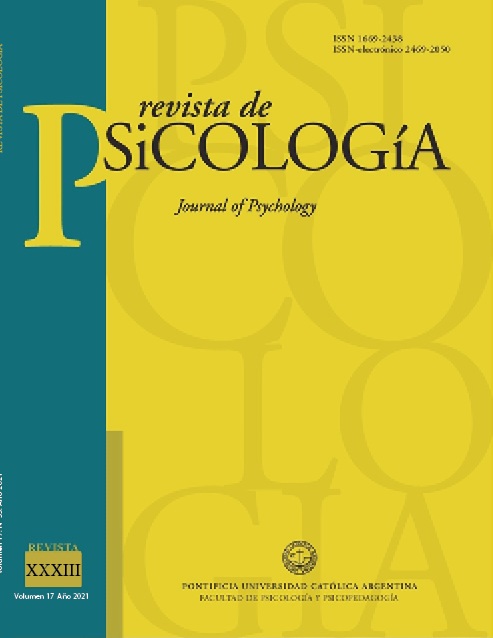Versión argentina de la escala Monash para la evaluación de la relación de los dueños con sus perros (MDORS-AR) y análisis de los factores demográficos asociados a sus resultados
DOI:
https://doi.org/10.46553/RPSI.17.33.2021.p7-21Palabras clave:
Vínculo humano-animal, Apego, Interacción perro-persona, Cercanía emocional, Costos percibidos de la tenencia de mascotasResumen
La escala Monash de relación del dueño con su perro evalúa la percepción del dueño del vínculo con su perro y es ampliamente utilizada en las investigaciones del área. El objetivo del presente trabajo fue validar una versión en español de la escala con una población argentina. Para ello se administró la escala junto a una encuesta demográfica, tanto a través de internet como de manera presencial, a 1703 personas. En primer lugar, los ítems se agruparon en tres componentes principales tal como se observó en la estructura factorial de la versión original de la escala. En segundo lugar, hallamos que la forma de administración influye en los resultados ya que la personas que respondieron por internet refirieron sentirse más cercanas a sus perros y percibieron como menos costoso su mantenimiento que las que contestaron presencialmente. En tercer lugar, hubo diversas asociaciones con características demográficas: las personas que viven solas interactúan más con su perro, aquellas sin hijos reportaron una mayor interacción y cercanía emocional, los perros castrados y las hembras son percibidos como más costosos y las personas con vínculos más añejos con sus perros se sienten más cercanas emocionalmente a ellos, aunque interactúan menos. En conclusión, la presente versión de la escala resulta valida y sensible para detectar diferencias individuales respecto de la percepción de la relación de los dueños con sus perros.
Descargas
Citas
Bennett, P. C., & Rohlf, V. I. (2007). Owner-companion dog interactions: Relationships between demographic variables, potentially problematic behaviours, training engagement and shared activities. Applied Animal Behaviour Science, 102(1–2), 65–84. https://doi.org/10.1016/j.applanim.2006.03.009
Bowling, A. (2005). Mode of questionnaire administration can have serious effects on data quality. Journal of Public Health, 27(3), 281–291. https://doi.org/10.1093/pubmed/fdi031
Couper, M. P. (2000). Web surveys: A review of issues and aproaches. Public Opinion Quarterly at University of Georgia On, 64, 464–494.
Diaz Videla, M., & Olarte, M. A. (2017). Dogs ’ Demographic Characteristics Associated with Relationship Differences Perceived by the Guardian, European Scientific Journal. 6, 218-232.
Diaz Videla, M., & Olarte, M. A. (2016). Animales de compañía, personalidad humana
y los beneficios percibidos por los custodios. PSIENCIA Revista latinoamericana de ciencia psicológica, 8(2), 1–19. https://doi.org/10.5872/psiencia/8.2.21
Dotson, M. J., & Hyatt, E. M. (2008). Understanding dog-human companionship. Journal of Business Research, 61(5), 457–466. https://doi.org/10.1016/j.jbusres.2007.07.019
Dwyer, F., Bennett, P. C., & Coleman, G. J. (2006). Development of the Monash Dog Owner Relationship Scale (MDORS). Anthrozoos, 19(3), 243–256. https://doi.org/10.2752/089279306785415592
Dzik, V., Barrera, G. & Bentosela, M. (2018) La importancia de la oxitocina en el vínculo entre perros y personas. Interdisciplinaria. Revista de Psicología y Ciencias Afines. Interdisciplinaria, 35[2], 527-542.
Friedmann, E., & Son, H. (2009). The Human-Companion Animal Bond: How Humans Benefit. Veterinary Clinics of North America - Small Animal Practice, 39(2), 293–326. https://doi.org/10.1016/j.cvsm.2008.10.015
González-Ramírez, M. T., Vanegas-Farfano, M., & Landero-Hernández, R. (2017). Versión mexicana de la escala Monash de relación del dueño con su perro (MDORS- M). Alternativas En Psicología, 107–123. Retrieved from http://www.alternativas.me/26-numero-37-febrero-julio-2017/149-version-mexicana-de-la-escala-monash-de-relacion-del-dueno-con-su-perro-mdors-m
Grandcolas, U., And, R. R., & Marusenko, K. (2003). Ursula Grandcolas , Ruth Rettiei and Kira Marusenko Web Survey Bias : Sample or Mode Effect ? Journal of Marketing Management, 19(Couper 2000), 541–561.
Handlin, L., Nilsson, A., Ejdebäck, M., Hydbring-Sandberg, E., & Uvnäs-Moberg, K. (2012). Associations between the psychological characteristics of the human-dog relationship and oxytocin and cortisol levels. Anthrozoos, 25(2), 215–228. https://doi.org/10.2752/175303712X13316289505468
Heerwegh, D., & Loosveldt, G. (2008). Face-to-face versus web surveying in a high-internet-coverage population: Differences in response quality. Public Opinion Quarterly, 72(5), 836–846. https://doi.org/10.1093/poq/nfn045
Howell, T. J., Toukhsati, S., Conduit, R., & Bennett, P. (2013). Do dogs use a mirror to find hidden food? Journal of Veterinary Behavior: Clinical Applications and Research, 8(6), 425–430. https://doi.org/10.1016/j.jveb.2013.07.002
Marinelli, L., Adamelli, S., Normando, S., & Bono, G. (2007). Quality of life of the pet dog: Influence of owner and dog’s characteristics. Applied Animal Behaviour Science, 108(1–2), 143–156. https://doi.org/10.1016/j.applanim.2006.11.018
O’Haire, M. (2010). Companion animals and human health: Benefits, challenges, and the road ahead. Journal of Veterinary Behavior: Clinical Applications and Research, 5(5), 226–234. https://doi.org/10.1016/j.jveb.2010.02.002
Odendaal, J. S. J., & Meintjes, R. A. (2003). Neurophysiological correlates of affiliative behaviour between humans and dogs. Veterinary Journal, 165(3), 296–301. https://doi.org/10.1016/S1090-0233(02)00237-X
Polheber, J. P., & Matchock, R. L. (2013). The presence of a dog attenuates cortisol and heart rate in the Trier Social Stress Test compared to human friends. Journal of Behavioral Medicine, 37(5), 860–867. https://doi.org/10.1007/s10865-013-9546-1
Rehn, T., & Keeling, L. J. (2016). Measuring dog-owner relationships: Crossing boundaries between animal behaviour and human psychology. Applied Animal Behaviour Science, 183, 1–9. https://doi.org/10.1016/j.applanim.2016.07.003
Rehn, T., Lindholm, U., Keeling, L., & Forkman, B. (2014). I like my dog, does my dog like me? Applied Animal Behaviour Science, 150, 65–73. https://doi.org/10.1016/j.applanim.2013.10.008
Rohlf, V. I., Bennett, P. C., Toukhsati, S., & Coleman, G. (2012). Beliefs underlying dog owners’ health care behaviors: Results from a large, self-selected, internet sample. Anthrozoos, 25(2), 171–185. https://doi.org/10.2752/175303712X13316289505341
Sheppard, G., & Mills, D. (2002). The Development of a Psychometric Scale for the Evaluation of the Emotional Predispositions of Pet Dogs Journal Issue. International Journal of Comparative Psychology, 15, 201–222. Retrieved from papers://eba95c07-21c6-4247-a2f7-57339f1ca15a/Paper/p11868
Tabachnick, B.G., & Fidell, L.S. (2013). Using Multivariante Statistics, 6th Edition, Pearson.
Thorn, P., Howell, T. J., Brown, C., & Bennett, P. C. (2015). The canine cuteness effect: Owner-perceived cuteness as a predictor of human–dog relationship quality. Anthrozoos, 28(4), 569–585. https://doi.org/10.1080/08927936.2015.1069992
Van Herwijnen, I. R., Van Der Borg, J. A. M., Naguib, M., & Beerda, B. (2018). The existence of parenting styles in the owner-dog relationship. PLoS ONE, 13(2), 1–14. https://doi.org/10.1371/journal.pone.0193471
Descargas
Publicado
Cómo citar
Número
Sección
Licencia




















